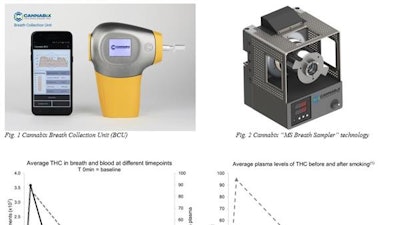
Cannabix Technologies, a developer of marijuana breathalyzer devices for law enforcement and the workplace, said it has successfully tested a supplemental version of its FAIMS technology for detection of delta-9 THC and related analytes in human breath in an independent experimental study. The study showed correlation between breath samples collected and analyzed with Cannabix hardware and blood plasma levels of THC.
The company’s handheld Breath Collection Unit and newly developed laboratory “MS Breath Sampler” were used together to provide a new method for drug detection that complements mass spectrometry (MS), and has the potential to decrease laboratory analysis times and operating costs, while maintaining sensitive, precise results. The company has developed a unique breath analysis system, capable of sampling breath for low volatility analytes, like THC, and can be completed within seconds, with no sample preparation needed.
This novel system, developed by Cannabix scientists and engineers, was recently tested in an independent study conducted by Dr. Phillip Olla of Audacia Bioscience in Ontario.
THC in Breath & Blood Data
The experimental study included six subjects with a 60%-40% between men and women with an average age of 23 years. Breath and blood samples were taken simultaneously at the baseline (a timepoint before smoking cannabis) and incremental time points (after smoking cannabis) out to 1 hour and 40 minutes after smoking (it should be noted that Cannabix has been able to detect and confirm THC in breath using the same hardware out to 4 hours after smoking in recent lab testing). Breath samples were taken with the Cannabix BCU, and analyzed using the Cannabix Mass Spectrometer (MS) Breath Sampler coupled to Thermo TSQ Quantum Ultra MS. THC fragments were analyzed using Thermo Xcalibur software and areas under the chromatogram curves (AUC) were determined using the software’s detection feature. Blood serum samples were analyzed at Analytical Facility for Bioactive Molecules at The Hospital for Sick Children (Toronto, ON, Canada) using LC/MS/MS, according to conventional standard operating procedures.
The resulting data (see Fig. 3 below) provides an excellent correlation between human breath samples collected and analyzed with the Cannabix hardware and blood plasma levels of THC. Furthermore, the data from this experimental study supports literature by showing the same trends in THC metabolism, and that blood and breath levels of THC over time correlate with a high degree of accuracy - within one or two hours after smoking (Fig. 4). Readers should note that blood is currently the standard measurement for law enforcement, toxicologists and evidence used in courts of law. The BCU is also being used with the Cannabix portable FAIMS THC detection unit.
Cannabix Sr. Analytical Chemist, Dr. Jared Boock stated, “This study shows the capability of the Cannabix Breath Analysis system to easily and rapidly collect breath samples in the field and correlate to blood THC levels. Law enforcement and toxicologists rely on gold standard mass spectrometry results to confirm drug presence in blood. We have developed a truly ground-breaking breath analysis tool capable of breath sampling for THC, within seconds, with no sample preparation needed. Furthermore, we were able to store, ship and analyze samples for up to 40 hours after they were taken in the field.”






















